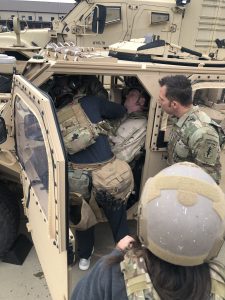
This week we completed our last round of scheduled beneficiary interviews, effectively signaling that our coursework is in its penultimate stage. One major takeaway from this last week, however, is that the potential for our product extends beyond the Demo Day of April 18th, and we are excited to chase that.
We spoke with student developers and technology consultants, Green Beret captains and communication sergeants, and even a Telehealth nurse. While included at the end of this blog, the summation of these conversations is a validation that the work of this semester has the potential to be successful from three main directions: first and foremost, there is strong runway in the special forces community. Second, that commercial niches are worth pursuing after successful deployment in the military. Finally, that we as a team are heading down the right path from a mobile product development perspective.
As we look ahead, though, we also spent time this week reflecting on where we started. As we will show in our in-class presentation this week, the three versions of our demonstration app reflect the stages of this product development cycle centered around beneficiary discovery. Our group understanding of the military telemedicine landscape was near-zero when we first talked with Cpt. Hinnant in January, and now he is complimenting us on our “fluency with the problem lingo” and is grateful for the progress we’ve made in this relatively short time. In our presentation we will highlight some of the major stages (as well as the notable high’s and low’s) of this experience.
To summarize here, however, it’s safe to say that this project has been nothing like an ordinary “course”. It has been an experiment of our own entrepreneurial, creative, and relationship-making abilities that has doubled as an opportunity to benefit the safety and experience of highly professional men and women in the United States Military. We cannot imagine any greater reward from a short-term, real-world scholastic experience. For that, we are immensely grateful to all of those who make it possible.
______________________________________________________________
Interview Summaries:
(3) Cpt. AJ, SFC AK, LT MC — SF Communications (18E)
-
- “The App must have toggle switch for low/high bandwidth”
- “All traffic outside the version 1 app will be encrypted by the network that already exist, so you don’t need to lose time programming that into your first version”
- “For photos, you’ll need to incorporate way to scrape any metadata in the app (like geolocating) — this will be important for the security considerations”
(2) Cpt. Drew Hinnant and Cpt. Phil Cotter — SF Team Leaders (18A)
-
- “I really see applicability across the whole SOF enterprise”
- Priority now is getting into a training program (mountain path, SOFACC, or even one of the larger SOCOM rotations). Then look to JCet trainings before full time deployment
- Action item: schedule demo presentation for day other than 4/18 to show 4th battalion command
(1) Eileen H. — (Maine) Stroke Center Coordinator (specific to Telehealth/Tele-stroke)
-
- Test: That EMS teams in rural areas would benefit from our product
- Result: “Not really…” These types of teams already have well established procedures and channels with the hospitals they serve to do the best they can.
(1) Paul Ford — CEO of Postlight (mobile service and product studio, NY)
-
- “Your version current plan is accurate. The app is completely decentralized — it doesn’t require central authority — that’s a great model. This is essentially just smarter digital paper”
- “As you get bigger, you’ll want to engage with shops like us and we’ll be happy to keep in touch with you. You’ll also want to consider relationship managers (like Salesforce) as you go into version two.”
- “For your business model, you will surely want to consider (for both version one and two) how you organize, and potentially sell, the injury, treatment, and outcome data.
- (1) Rob Versaw — Product Manager at Wayfair
-
- “With user experience, keep in mind the Cognitive Churn — you need continuity of actions with each interface you present”
- “You get in trouble when you try to bite off too much too soon — its best to address your niche and grow… don’t come out saying you want to take all of it. Showing how you plan to scale is important
(2) Yash and Luke, co-leaders of Duke BlueTech
-
- (This conversation was essentially a cost exploration for initial development of our product by vetted student developers)
- “Over the summer, it may be hard to get consistent buy-in. The app would need to be developed by at least four developers on part-time schedules since everyone on our pre-vetted team has internships they’d have to work around.”
- Total cost would be low, though, between “$2000 and $5000”







 – Discussion on Message Broker (RabbitMQ vs PostgressQL) and full relational database management systems (RDBMS).
– Discussion on Message Broker (RabbitMQ vs PostgressQL) and full relational database management systems (RDBMS).




